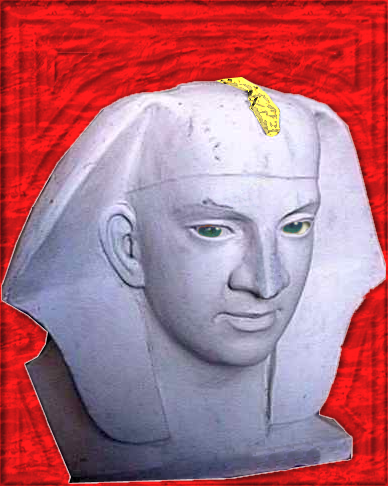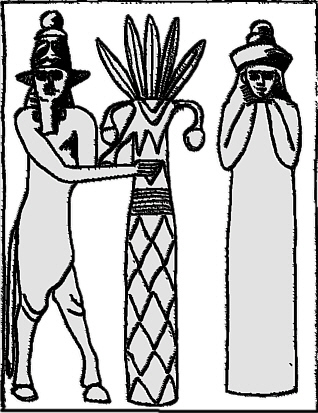|
 ISIS ISIS
Isis [IS] was an Egyptian Throne
Goddess dating back to the 5th dynasty.
Her name literally means the feminine aspect of the
throne - also the Queen of the throne. However, the
hieroglyph for her name used originally meant (female)
of flesh, i.e. mortal, and she may simply have
represented deified Earthly queens of the World. She was
most prominently remembered as the wife of Horus, or, in
later periods, as the wife of Osiris and mother of
Horus, and was worshiped as the archetypal wife and
mother. Isis is the feminine archetype for
creation - the goddess of fertility and motherhood. She
has gone by many names, such as the 'virgin' Mary, and
played many roles in history and mythology -as
goddess, virgin, and female creator of life.
Isis represents the
feminine aspects of life - male and female alike, for
she represents creation, rebirth, reincarnation,
Ascension, intuition, psychic abilities, higher
frequency vibrations, love and compassion. In
other words, she represents nature and all that is
natural of our existence. She is the mother
nurturer - the High Priestess - the Goddess of creation,
and perhaps representing Eve, the first woman and
mother of all.
Isis became prominent
late in Egyptian history when it began to absorb the
cults of many other goddesses. It eventually spread
outside Egypt throughout the Middle East and Europe,
with temples to her built as far away as the British
Isles. Remnants of her worshipers remained in Christian
Europe as late as the 6th century, when at that time,
her memory was honored as the virgin mother of the
Chrisitan god, Jesus. [At right is a photo taken
of Betty Rhodes dressed as Isis for an Egyptian theme
play in 1978.]
|
|
|
 RA
RA
Ra (sometimes spelled Rê) is the sun-god of Heliopolis
in ancient Egypt. Ra originally meant "mouth" in the
Egyptian language, and was a reference to his creation
of the deities of the Ogdoad system, excluding the 8
concepts which created him, by the power of speech
(compare how Yahweh was said to have created the world).
In later Egyptian dynastic times, Ra was subsumed into
the god Horus, as Re-Horakhty (and many variant
spellings).
The Eye of Ra,
or the Right Eye of Horus
The sun is either the entire body of Ra, or just his
eye. The symbols of Ra are the solar symbols of a golden
disk or the symbol ⊙ (circle with a point at its
centre). He was also associated with the Phoenix, as he
rose again each morning in flames.
The Eye of RA was a symbol that signified royal power,
yet on the numeration side denoted a decimal system
where round off was set to the first 6-terms. The
ancients believed this symbol of indestructibility would
assist in rebirth, due to their beliefs about the soul.
The more recent tradition of freemasonry adopted the
symbol in the form of the Eye of Providence and as such
it has survived to this day, and appears as the Eye of
Providence on the recto of the Great Seal of the United
States. The Eye of Horus (flanked by Nekhbet and Wadjet)
was found under the 12th layer of bandages on
Tutankhamun's mummy.
Horus was an ancient god in Egyptian mythology who
dramatically evolved over the whole of Egyptian history.
Early on, he became identified as a sky god, where one
of his eyes was the sun, and the other the moon. His
weaker eye later became less important in his mythology,
and he became more strongly aligned with the sun,
particularly when the cult of Thoth, a moon god, arose.
As the sun, or rather, with his eye as the sun, his eye
had a special meaning, and became a symbol of power when
combined with the hieratic aspects of the subject.
Originally, Ra held this position, but as Horus
gradually became more important, he transformed into a
sun god, so Horus became thought of as Ra, or rather
Ra-Herakhty ("Ra, who is Horus of the two horizons").
Later Horus-Eye numeration decreased in importance in
Egyptian life, with hieratic, demotic and later
improvements in Egyptian arithmetic solving the oldest
Horus-Eye problem. The oldest Horus-Eye problem was to
write any number, like one (1), exactly, without
throwing away any piece of the number.
|
|
|
 EL [depiction
at left is of Enlil and Ninlil] EL [depiction
at left is of Enlil and Ninlil]
Ellil
by Micha F. Lindemans
"The Akkadian god of earth and wind. He
is the son of Ansar and Kisar, the primordial deities,
and the father of the moon god Sin. Together with Ea and
Anu he forms a powerful triad of gods in the ancient
Mesopotamian religion. He is represented wearing a
headband which is decorated with horns. He is equivalent
to the Sumerian god Enlil."
Enlil
by Micha F. Lindemans
"In
ancient Sumero-Babylonian myth, Enlil ("lord wind") is
the god of air, wind and storms. Enlil is the foremost
god of the Mesopotamian pantheon, and is sometimes
referred to as Kur-Gal ("great mountain"). In the
Sumerian cosmology he was born of the union of An
heaven and Ki earth. These he separated, and he
carried off the earth as his portion. In later times
he supplanted Anu as chief god. His consort is Ninlil
with whom he has five children: Nanna, Nerigal,
Ningirsu, Ninurta, and Nisaba.
Enlil holds
possession of the Tablets of Destiny which gives him
power over the entire cosmos and the affairs of man.
He is sometimes friendly towards mankind, but can
also be a stern and even cruel god who punishes man
and sends forth disasters, such as the great Flood
which wiped out humanity with the exception of
Atrahasis. Enlil is portrayed wearing a crown with
horns, symbol of his power. His most prestigious
temple was in the city Nippur, and he was the patron
of that city. His equivalent is the Akkadian god
Ellil."
|
|

 ISIS
ISIS
 RA
RA EL [depiction
at left is of Enlil and Ninlil]
EL [depiction
at left is of Enlil and Ninlil]
